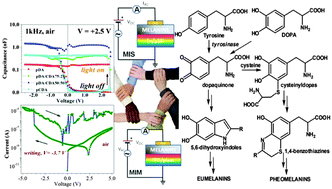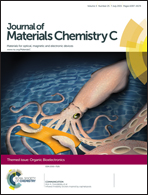From commercial tyrosine polymers to a tailored polydopamine platform: concepts, issues and challenges en route to melanin-based bioelectronics
Abstract
Over the past decade synthetic melanins, melanin-like polymers and melanin-based copolymers have been the focus of growing attention as soft biocompatible functional materials for engineering high performance, low cost optoelectronic devices, such as memory devices, light emitting diodes and field effect transistors. The unique combination of physicochemical properties of melanins, such as broad band absorption in the UV-visible range, intrinsic free radical character, water-dependent hybrid ionic–electronic conductor behaviour and excellent biocompatibility, have inspired use of melanic polymers as valuable functional materials for organic bioelectronics. However, several gaps and issues still hinder rapid progress of melanin-based organic electronics and bioelectronics, including in particular the limited contribution of electronic conductivity and current decay with time under biasing. The aim of this paper is to provide an overview of the structural and optoelectronic properties of melanins and to bring to focus current gaps and challenges in the development of melanin-based materials for bioelectronics. Starting from commercial samples, the paper surveys different melanin-type materials with special emphasis on the potential of polydopamine (pDA), a highly adhesive mussel-inspired melanin-type platform, for incorporation in optoelectronic devices. Simple chemical tailoring procedures for engineering pDA-based n-type polymers and photoresponsive materials for photocapacitive sensors are eventually illustrated.

- This article is part of the themed collection: Bioelectronics

 Please wait while we load your content...
Please wait while we load your content...